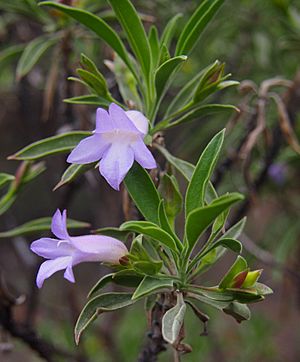Limestone fuchsia facts for kids
Quick facts for kids Limestone fuchsia |
|
|---|---|
 |
|
| Scientific classification | |
| Genus: |
Eremophila (plant)
|
| Species: |
freelingii
|
| Synonyms | |
|
|
Limestone fuchsia (also called rock fuchsia bush) is a beautiful flowering plant found only in Australia. Its scientific name is Eremophila freelingii. This plant belongs to the figwort family. It grows as a shrub with sticky, hairy leaves that look like spear tips. Its flowers are usually light to dark purple. You can find this plant growing naturally in Queensland, New South Wales, and South Australia.
Contents
What Limestone Fuchsia Looks Like
Eremophila freelingii is a small to medium-sized shrub. It usually grows to be about 0.8 to 2 meters (2.6 to 6.6 feet) tall and wide. Its branches are covered with white hairs and feel rough because of raised bumps where leaves used to be.
The leaves of this plant can vary in size. They are mostly oval or shaped like a spear tip. They are usually 35 to 80 millimeters (1.4 to 3.1 inches) long and 5 to 10 millimeters (0.2 to 0.4 inches) wide. The leaves look shiny and feel sticky because they have a natural sticky substance called resin. They can have a few hairs or many hairs, and sometimes the resin hides the hairs.
The flowers grow either alone or in small groups of up to three. They appear where the leaves meet the stem, on a stalk that is 8 to 40 millimeters (0.3 to 1.6 inches) long. Each flower has five shiny, sticky sepals. Sepals are like small leaves that protect the flower bud. These sepals can be green or purple and are different in size and shape. They are 10 to 19 millimeters (0.4 to 0.7 inches) long.
The petals of the flower are 20 to 32 millimeters (0.8 to 1.3 inches) long. They are joined together at the bottom to form a tube shape. This petal tube is light to dark purple and has hairs on the outside. The inside of the petal tube is full of soft, woolly hairs. There are four stamens (the parts that make pollen) inside the petal tube.
Limestone fuchsia flowers throughout the year, but you'll see the most flowers from August to November. After flowering, the plant produces dry, woody, oval-shaped fruits that are 6 to 9 millimeters (0.2 to 0.4 inches) long.
How It Got Its Name
The scientific name for this plant, Eremophila freelingii, was first officially described in 1859. This was done by a scientist named Ferdinand von Mueller. The second part of the name, freelingii, was chosen to honor Arthur Henry Freeling. He was an important surveyor in South Australia from 1849 to 1861.
Where Limestone Fuchsia Grows
You can find Eremophila freelingii in several parts of Australia. In South Australia, it grows in clay soils in rocky areas. In New South Wales, it is found in rocky places, often near Mulga trees. It also grows in the southern part of the Northern Territory and the far southwest of Queensland. It commonly grows on rocky hills or flat, stony ground.
Uses of the Plant
Traditional Uses
Different groups of Aboriginal people had various names for limestone fuchsia, including arrethe. They used this plant for traditional medicine. For example, it was used to help treat skin problems like scabies and other skin lesions.
Growing Limestone Fuchsia
This plant is not very common in gardens, but some types are worth growing. It can be tricky to grow new plants from seeds or cuttings. It is usually grown by grafting it onto another plant called Myoporum. Grafting means joining parts of two plants together so they grow as one.
Limestone fuchsia likes soil that drains water well. It grows best in a sunny spot or a place with some shade. It can handle very dry conditions and is quite resistant to most frosts, unless they are very severe.


